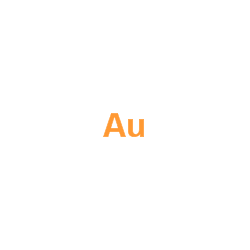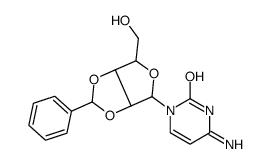Potassium tetrabromoaurate(III)
Modify Date: 2024-04-05 19:09:17

Potassium tetrabromoaurate(III) structure
|
Common Name | Potassium tetrabromoaurate(III) | ||
|---|---|---|---|---|
| CAS Number | 14323-32-1 | Molecular Weight | 555.68100 | |
| Density | N/A | Boiling Point | 25°C | |
| Molecular Formula | AuBr4K | Melting Point | -132°C | |
| MSDS | N/A | Flash Point | N/A | |
| Name | potassium tetrabromoaurate |
|---|---|
| Synonym | More Synonyms |
| Boiling Point | 25°C |
|---|---|
| Melting Point | -132°C |
| Molecular Formula | AuBr4K |
| Molecular Weight | 555.68100 |
| Exact Mass | 551.60400 |
| LogP | 3.37990 |
|
Section 1: Product Identification Chemical Name:Potassium tetrabromoaurate (III) dihydrate, 99% CAS Registry Number:14323-32-1 Formula:KAuBr4.2H2O EINECS Number:238-268-8 Chemical Family:halometallate salt Synonym:Potassium gold tetrabromide hydrate
Section 2: Composition and Information on Ingredients IngredientCAS NumberPercentACGIH (TWA)OSHA (PEL) Title Compound14323-32-1100%no datano data Section 3: Hazards Identification Emergency Overview:Irritating to skin, eyes and respiratory tract. Primary Routes of Exposure:Contact with skin and eyes. Inhalation of dust. Eye Contact:Causes slight to mild irritation of the eyes. Skin Contact:Causes slight to mild irritation of the skin. Inhalation:Irritating to the nose, mucous membranes and respiratory tract. Ingestion may lead to dermatitis, dizziness, metallic taste, abdominal cramps, vomiting, bloody diarrhea, Ingestion: weakness, and convulsions. Irritating to skin, eyes and respiratory tract. Gold compounds may cause impairment of kidney and bone Acute Health Affects: marrow function, abdominal cramps, vomiting, bloody diarrhea, weakness, and convulsions. Prolonged exposure to gold compounds may lead to reduced red and white blood cell generation. Prolonged Chronic Health Affects: exposure to bromides may cause skin rashes, memory loss, irritability, and headache. NTP:No IARC:No OSHA:No SECTION 4: First Aid Measures Immediately flush the eyes with copious amounts of water for at least 10-15 minutes. A victim may need Eye Exposure: assistance in keeping their eye lids open. Get immediate medical attention. Wash the affected area with water. Remove contaminated clothes if necessary. Seek medical assistance if Skin Exposure: irritation persists. Remove the victim to fresh air. Closely monitor the victim for signs of respiratory problems, such as difficulty Inhalation: in breathing, coughing, wheezing, or pain. In such cases seek immediate medical assistance. Seek medical attention immediately. Keep the victim calm. Give the victim water (only if conscious). Induce Ingestion: vomiting only if directed by medical personnel. SECTION 5: Fire Fighting Measures Flash Point:not applicable Autoignition Temperature:none Explosion Limits:none Extinguishing Medium:None. Material is non-flammable. Special Fire Fighting Procedures:No special fire fighting procedures required. Hazardous Combustion andnone Decomposion Products: Unusual Fire or Explosion Hazards: No unusual fire or explosion hazards. SECTION 6: Accidental Release Measures To avoid raising dust, small spills may be mixed with diatomaceous earth, sand, vermiculite or other suitable Spill and Leak Procedures: inert material and swept up. SECTION 7: Handling and Storage Handling and Storage:Store solid in a tightly sealed container. SECTION 8: Exposure Controls and Personal Protection Eye Protection:Always wear approved safety glasses when handling a chemical substance in the laboratory. Skin Protection:Wear protective clothing and gloves. Consult with glove manufacturer to determine the proper type of glove. Ventilation:Material may form a fine dust. If possible, handle the material in an efficient fume hood. If in form of fine dust and ventilation is not available a respirator should be worn. The use of respirators Respirator: requires a Respirator Protection Program to be in compliance with 29 CFR 1910.134. Ventilation:Material may form a fine dust. If possible, handle the material in an efficient fume hood. Additional Protection:No additional protection required. SECTION 9: Physical and Chemical Properties Color and Form:reddish-brown xtl. Molecular Weight:555.71 (591.74) Melting Point:no data Boiling Point:no data Vapor Pressure:not applicable Specific Gravity:no data Odor:none Solubility in Water:very soluble SECTION 10: Stability and Reactivity Stability:air and moisture stable Hazardous Polymerization:no hazardous polymerization Conditions to Avoid:none Incompatibility:Active metals Decomposition Products:potassium bromide, gold, bromine, hydrobromic acid and water. SECTION 11: Toxicological Information RTECS Data:No information available in the RTECS files. Carcinogenic Effects:no data Mutagenic Effects:no data Tetratogenic Effects:no data SECTION 12: Ecological Information Ecological Information:No information available SECTION 13: Disposal Considerations Disposal:Dispose of according to local, state and federal regulations. SECTION 14: Transportation Shipping Name (CFR):Non-hazardous Hazard Class (CFR):NA Additional Hazard Class (CFR):NA Packaging Group (CFR):NA UN ID Number (CFR):NA Shipping Name (IATA):Non-hazardous Hazard Class (IATA):NA Additional Hazard Class (IATA):NA Packaging Group (IATA):NA UN ID Number (IATA):NA SECTION 15: Regulatory Information TSCA:Listed in the TSCA inventory. SARA (Title 313):Title compound not listed. Second Ingredient:none SECTION 16 - ADDITIONAL INFORMATION N/A |
|
~% 
Potassium tetra... CAS#:14323-32-1 |
| Literature: Gmelin Handbook: Au: MVol.3, 6.3, page 618 - 621 |
|
~% 
Potassium tetra... CAS#:14323-32-1 |
| Literature: Booth; Bhargava; Bond; O'Mullane Journal of Physical Chemistry B, 2006 , vol. 110, # 25 p. 12419 - 12426 |
| Precursor 2 | |
|---|---|
| DownStream 1 | |
| potassium,gold(3+),tetrabromide |
| EINECS 238-268-8 |
| MFCD00049650 |
| Potassium Tetrabromoaurate(Iii) Dihydrate |



